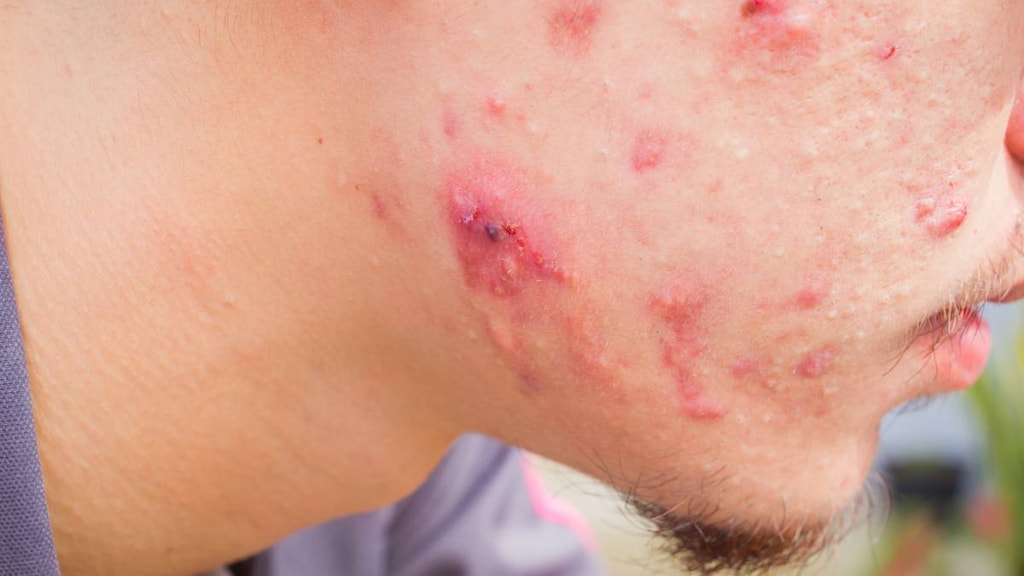Dosage Forms
Excipient information presented when available (limited, particularly for generics); consult specific product labeling.
Gel, External:
Veltin: Clindamycin phosphate 1.2% and tretinoin 0.025% (30 g, 60 g) [contains edetate disodium, methylparaben, propylene glycol]
Ziana: Clindamycin phosphate 1.2% and tretinoin 0.025% (30 g, 60 g) [contains methylparaben, propylparaben]
Generic: Clindamycin phosphate 1.2% and tretinoin 0.025% (30 g, 60 g)
Pharmacology
Mechanism of Action
Clindamycin reversibly binds to 50S ribosomal subunits preventing peptide chain elongation thus inhibiting bacterial protein synthesis. Clindamycin exhibits in vitro activity against Cutibacterium acnes, an organism associated with acne vulgaris. Topical tretinoin is believed to decrease follicular epithelial cells cohesiveness and increase follicular epithelial cell turnover resulting in decreased microcomedo formation and increased expulsion of comedones.
Pharmacokinetics/Pharmacodynamics
Absorption
Topical: Tretinoin: Minimal systemic absorption; Clindamycin: Low, but variable systemic absorption
Use: Labeled Indications
Acne: For the treatment of acne vulgaris in patients ≥12 years.
Contraindications
Regional enteritis, ulcerative colitis, history of antibiotic-associated colitis
Canadian labeling: Additional contraindications (not in US labeling): Hypersensitivity to clindamycin, tretinoin, or any component of the formulation; hypersensitivity to lincomycin
Dosage and Administration
Dosing: Adult
Acne: Topical: Apply once daily in the evening or at bedtime
Dosing: Pediatric
Acne vulgaris: Topical: Children ≥12 years and Adolescents: Topical: Apply pea-size amount to entire face once daily in the evening or at bedtime; Note: Higher dosages (larger amount or more frequent use) have not been shown to improve efficacy and are associated with increased adverse effects (eg, skin irritation).
Administration
For external use only. Not for ophthalmic, oral, or intravaginal use. Prior to application, gently wash face with a mild soap and pat dry. Apply in the evening or at bedtime. Apply a pea-size amount to one fingertip and then dotted on chin, cheeks, nose, and forehead. Avoid contact with sunburned skin. Gently rub over entire face or entire affected area while avoiding eyes, mouth, angles of nose, and mucous membranes.
Storage
Store at 25°C (77°F); excursions permitted to 15°C to 30°C (59°F to 86°F); do not freeze. Protect from heat and light.
Drug Interactions
Aminolevulinic Acid (Systemic): Photosensitizing Agents may enhance the photosensitizing effect of Aminolevulinic Acid (Systemic). Avoid combination
Aminolevulinic Acid (Topical): Photosensitizing Agents may enhance the photosensitizing effect of Aminolevulinic Acid (Topical). Monitor therapy
Erythromycin (Systemic): May diminish the therapeutic effect of Clindamycin (Topical). Avoid combination
Erythromycin (Topical): May diminish the therapeutic effect of Clindamycin (Topical). Avoid combination
Multivitamins/Fluoride (with ADE): May enhance the adverse/toxic effect of Retinoic Acid Derivatives. Avoid combination
Multivitamins/Minerals (with ADEK, Folate, Iron): May enhance the adverse/toxic effect of Retinoic Acid Derivatives. Avoid combination
Multivitamins/Minerals (with AE, No Iron): May enhance the adverse/toxic effect of Retinoic Acid Derivatives. Avoid combination
Neuromuscular-Blocking Agents: Clindamycin (Topical) may enhance the neuromuscular-blocking effect of Neuromuscular-Blocking Agents. Monitor therapy
Porfimer: Photosensitizing Agents may enhance the photosensitizing effect of Porfimer. Monitor therapy
Verteporfin: Photosensitizing Agents may enhance the photosensitizing effect of Verteporfin. Monitor therapy
Adverse Reactions
Frequency not defined.
>10%: Dermatologic: Burning sensation of skin, desquamation, erythema, xeroderma
1% to 10%:
Dermatologic: Dermatitis, pruritus, skin irritation, stinging of the skin, sunburn
Gastrointestinal: Gastrointestinal symptoms (unspecified)
Respiratory: Nasopharyngitis
Warnings/Precautions
Concerns related to adverse effects:
- Photosensitivity: Tretinoin use is associated with increased susceptibility/sensitivity to ultraviolet (UV) light; avoid sunlamps or excessive sunlight exposure. Daily sunscreen use and other protective measures recommended. Use is not recommended in patients with sunburn.
- Skin irritation: Treatment can increase skin sensitivity to weather extremes of wind or cold. Also, concomitant topical medications (eg, medicated or abrasive soaps, cleansers, or cosmetics with a strong drying effect) should be used with caution due to increased skin irritation.
- Superinfection: Prolonged use may result in fungal or bacterial superinfection, including Clostridioides (formerly Clostridium) difficile-associated diarrhea (CDAD) and pseudomembranous colitis; CDAD has been observed >2 months postantibiotic treatment. Discontinue drug if significant diarrhea, abdominal cramps, or passage of blood and mucus occurs.
Concurrent drug therapy issues:
- Drug-drug interactions: Potentially significant interactions may exist, requiring dose or frequency adjustment, additional monitoring, and/or selection of alternative therapy. Consult drug interactions database for more detailed information.
Dosage form specific issues:
- Polysorbate 80: Some dosage forms may contain polysorbate 80 (also known as Tweens). Hypersensitivity reactions, usually a delayed reaction, have been reported following exposure to pharmaceutical products containing polysorbate 80 in certain individuals (Isaksson 2002; Lucente 2000; Shelley 1995). Thrombocytopenia, ascites, pulmonary deterioration, and renal and hepatic failure have been reported in premature neonates after receiving parenteral products containing polysorbate 80 (Alade 1986; CDC 1984). See manufacturer’s labeling.
Other warnings/precautions:
- Appropriate use: For external use only; not for ophthalmic, oral, or intravaginal use; avoid mucous membranes, eyes, mouth, and angles of nose.
Pregnancy
Pregnancy Risk Factor
C
Pregnancy Considerations
Adverse events were observed in animal reproduction studies using this combination topically. See individual agents.
Patient Education
- Discuss specific use of drug and side effects with patient as it relates to treatment. (HCAHPS: During this hospital stay, were you given any medicine that you had not taken before? Before giving you any new medicine, how often did hospital staff tell you what the medicine was for? How often did hospital staff describe possible side effects in a way you could understand?)
- Patient may experience skin irritation, itching, burning, peeling, or skin discoloration. Have patient report immediately to prescriber severe injection site irritation; severe diarrhea; black, tarry, or bloody stools; abdominal pain; or abdominal cramps (HCAHPS).
- Educate patient about signs of a significant reaction (eg, wheezing; chest tightness; fever; itching; bad cough; blue skin color; seizures; or swelling of face, lips, tongue, or throat). Note: This is not a comprehensive list of all side effects. Patient should consult prescriber for additional questions.
Intended Use and Disclaimer: Should not be printed and given to patients. This information is intended to serve as a concise initial reference for healthcare professionals to use when discussing medications with a patient. You must ultimately rely on your own discretion, experience and judgment in diagnosing, treating and advising patients.




